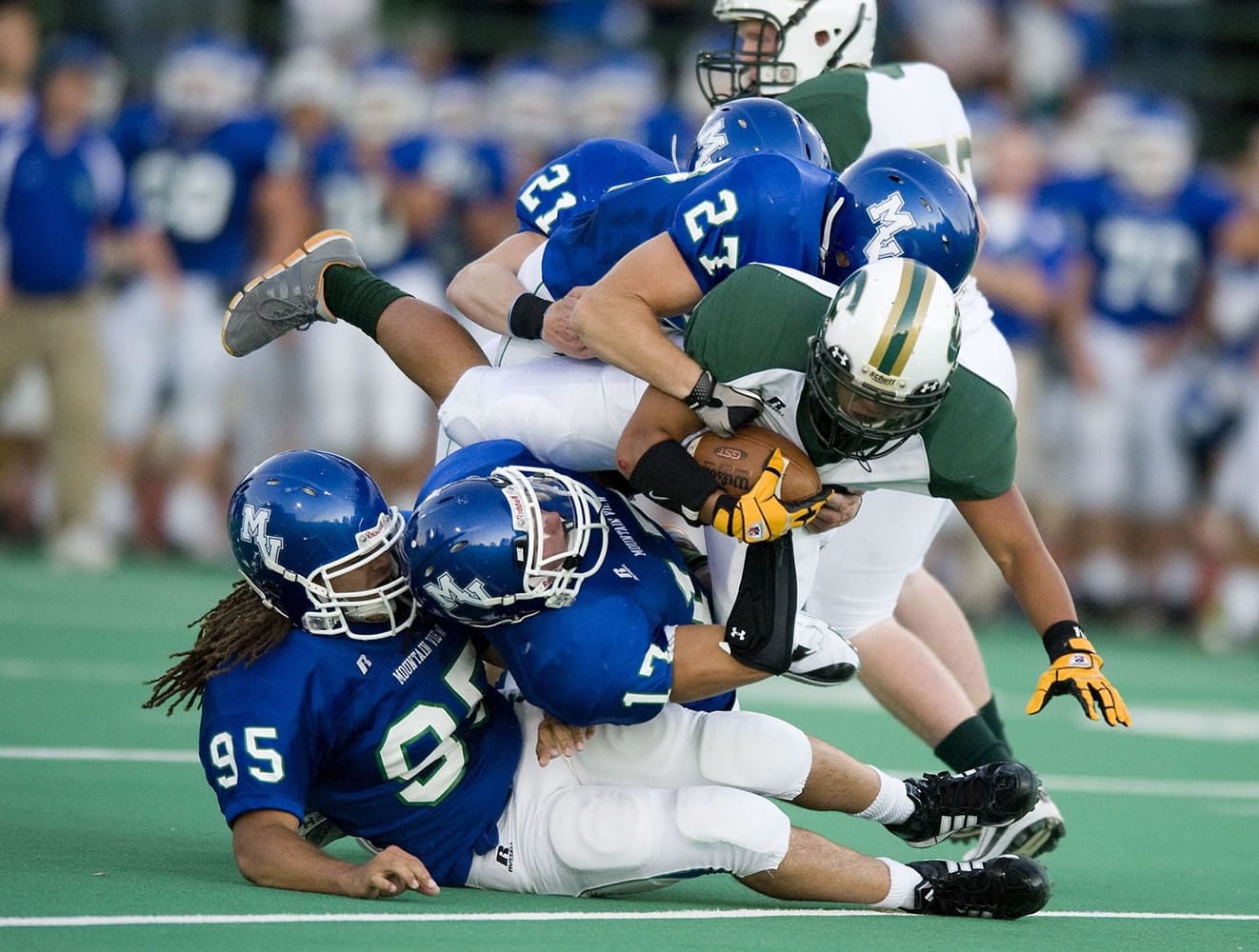The Union football player’s right arm was extended as he headed to the ground at McKenzie Stadium. His hand planted in the turf, but the force was too strong.
Immediately, he was in excruciating pain.
He had dislocated his elbow.
A few days later in a junior varsity game, a Mountain View athlete suffered the same injury, a dislocated elbow while trying to brace himself for a fall to the surface — the old-style AstroTurf at McKenzie Stadium.
Earlier this season, another Mountain View player dislocated his hip, and a Kelso athlete broke his leg at McKenzie.
Some are now wondering if the turf is the issue.
“I have a hard time believing it didn’t play a role in it,” Union coach Cale Piland said of Trevé Ensley’s elbow injury last week. “It doesn’t give like a natural surface does, and it doesn’t give like the new FieldTurf does.”
Mountain View coach Adam Mathieson, who also has reported several ankle injuries from his team on the turf this season, was careful with his words.
“As a football coach, I just coach my kids on the field the schedule says we play on. I am not an expert in facilities, so I would rather not speak to that,” he said.
Coaches and sideline observers have noted how their joints ache after just watching games at McKenzie.
“And I’m not even playing,” Piland said.
“If it had the right surface, it would be one of the top four or five stadiums in the state.”
For now, it looks as though McKenzie will continue to be a Blu-Ray stadium with a VHS surface.
“I will certainly agree that the stadium structure itself is one of the nicest in the state. I will certainly agree the turf is in rough shape,” said Steve Getsinger, director of school services for Evergreen Public Schools. “I won’t agree the turf has caused or contributed to any injuries. I don’t have any proof of that.”
Still, he would prefer to have the old turf replaced with the latest technology.
Coaches and administrators agree, though, that it is a difficult time to ask for money from taxpayers for athletic facilities, especially for a turf that likely would cost about $750,000.
“The district has to be careful,” Piland said. “People are losing their jobs. Where does a playing surface in a stadium rank in regard to that stuff?”
“In a perfect world, which would start with a healthy state and national economy, and therefore a healthy district budget, we’d probably replace that tomorrow,” Getsinger said. “We’re not in a healthy economic situation. Replacing the turf is under discussion. It’s been under discussion. But it’s no more than under discussion.”
There are other options as well to raise funds for the general athletic budget, but not necessarily for the stadium, Getsinger said. The district is looking into selling advertising at its facilities. Currently, there is no advertising at McKenzie Stadium or baseball and softball fields in the district.
Kiggins Bowl, which is home to three high school football teams — Skyview, Hudson’s Bay, and Fort Vancouver — has advertising.
Another possibility would be private fundraising. McKenzie Stadium is the home field for the four high schools in the Evergreen district — Evergreen, Heritage, Mountain View, and Union.
An informal survey of journalists who cover high school football across the state could not find another stadium with the old turf. Reporters from Seattle, Tacoma, Olympia, and Spokane reported all of the stadiums they attend have made the switch.
Kiggins Bowl was the county’s first high school facility to install an Astroturf field in 1997. But that field was replaced with a FieldTurf in 2008 at the cost of $750,000. Mick Hoffman, the athletic director for Vancouver Public Schools, said at the time that the warranty was for eight years but the district expected it to last for much longer.
The old-school rug at McKenzie was new school at the time of its placement. The surface was installed in the summer of 1999 to coordinate with the opening of Heritage High School.
Since then, the district opened another high school — Union in 2007 — making McKenzie Stadium the most heavily used high school facility in the county.
When the grass field at McKenzie was removed in 1999, it was replaced with a 1-foot layer of base rock, followed by a 2-inch layer of asphalt and a 1-inch cushion known as e-layer before being topped off by the AstroTurf playing surface.
While considered state-of-the-art at the time, it was also one of the last new “rugs” to be put in place before FieldTurf and other brands like it came on to the market.
The new turf has a closer resemblance to grass and also has more cushion — closer to natural grass.
Doc Harris Stadium installed an Astroplay surface in 2000. That surface was later replaced with a FieldTurf surface in 2010, as part of a $7 million stadium renovation that was part of a larger bond measure passed in 2007.
Washougal’s Fishback Stadium was then next facility to get FieldTurf in 2002. The Washougal School District is looking into the possibility of replacing that playing surface next summer.
Battle Ground added FieldTurf at District Stadium in 2006. The Battle Ground School Board recently approved the purchase of a FieldTurf surface to be installed at Prairie High School’s athletic fields.
Getsinger hopes to able to follow suit at McKenzie Stadium in the near future.
“Hopefully, eventually, we’ll be able to return to state-of-the-art turf,” Getsinger said.




